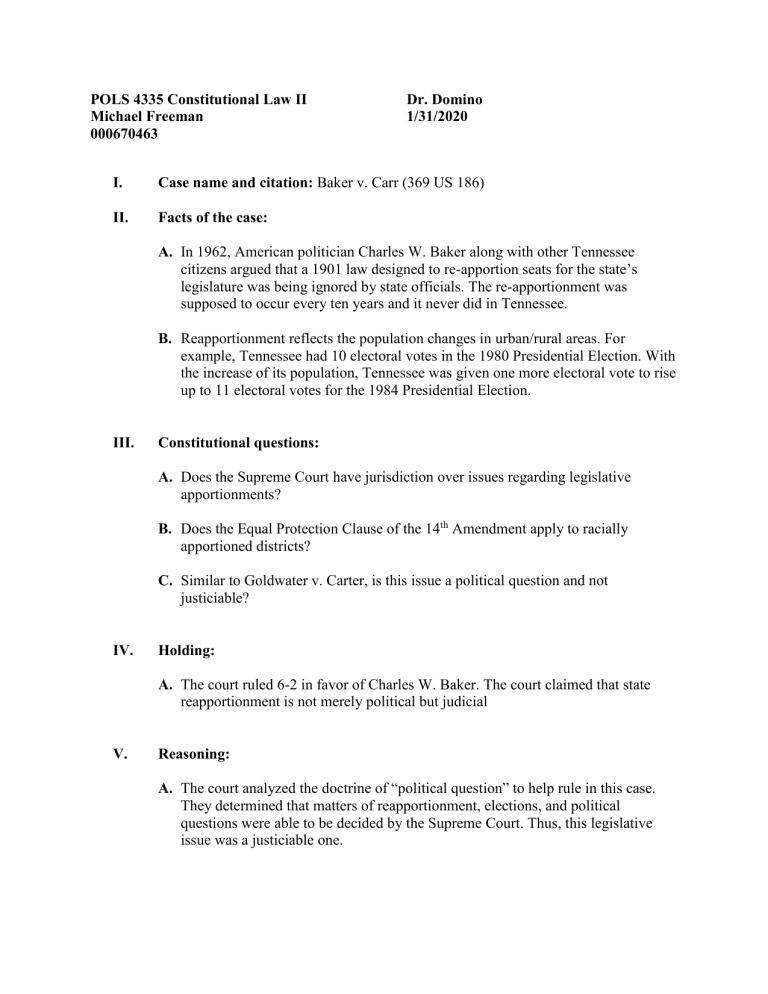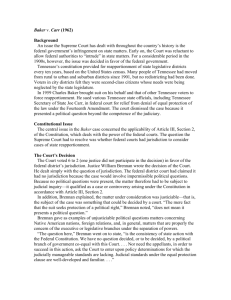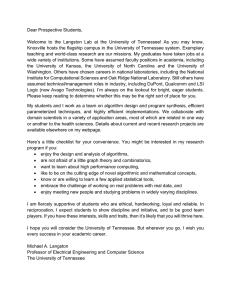
POLS 4335 Constitutional Law II Michael Freeman 000670463 Dr. Domino 1/31/2020 I. Case name and citation: Baker v. Carr (369 US 186) II. Facts of the case: A. In 1962, American politician Charles W. Baker along with other Tennessee citizens argued that a 1901 law designed to re-apportion seats for the state’s legislature was being ignored by state officials. The re-apportionment was supposed to occur every ten years and it never did in Tennessee. B. Reapportionment reflects the population changes in urban/rural areas. For example, Tennessee had 10 electoral votes in the 1980 Presidential Election. With the increase of its population, Tennessee was given one more electoral vote to rise up to 11 electoral votes for the 1984 Presidential Election. III. Constitutional questions: A. Does the Supreme Court have jurisdiction over issues regarding legislative apportionments? B. Does the Equal Protection Clause of the 14th Amendment apply to racially apportioned districts? C. Similar to Goldwater v. Carter, is this issue a political question and not justiciable? IV. Holding: A. The court ruled 6-2 in favor of Charles W. Baker. The court claimed that state reapportionment is not merely political but judicial V. Reasoning: A. The court analyzed the doctrine of “political question” to help rule in this case. They determined that matters of reapportionment, elections, and political questions were able to be decided by the Supreme Court. Thus, this legislative issue was a justiciable one. B. Justice Brennan referenced past court cases that pertained to this context. These cases feature the Court having to intervene in order to correct constitutional violations that resulted from the state government and officials. C. Justice Brennan also stated that Equal Protection clause in the 14th Amendment and the political questions merited judicial review. According to Justice Brennan, “The right asserted is within the reach of judicial protection under the Fourteenth Amendment.” VI. Separate opinions: A. Concurring: Justice Clark, Douglas, and Stewart agreed with the ruling but concurred with the reasoning. Justice Clark believes that the policy created by Tennessee legislatures is constitutional. What is troubling, however, is the actions of the Tennessee’s Assembly “allocating legislative seats to counties or districts created by it.” Justice Douglas agrees with the court on the ruling but he states that there is a problem with the relation between federal courts and state agencies. B. Dissenting: Justice Frankfurter and Harlan both dissented. They both state that it is time to question the Court’s role in political issues. Justice Frankfurter also stated that the plaintiffs’ complaint is simply that representatives are not “sufficiently numerous” and that the Court, just like argued in previous cases, had violated the Separation of Powers. VII. Impact: A. This case placed the controversy of gerrymandering on the political map. So much so that gerrymandering was not considered a political issue but rather a judicial one to which the Supreme Court can intervene in. This case created challenges such as “One person, one vote” issued by southern Black voters. This case overturned a previous ruling of Colgrove v. Green (1946).


